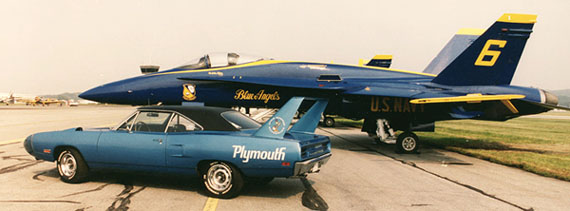The car with the largest United States, Plymouth Hemi Superbird, spoiler was manufactured in a short series of 78 units designed all them to homologate a racing car for the NASCAR. Protagonist of t-shirts, video games and also with a role as a supporting actor in the movie CARS, this Superbird is part of the American automotive culture.
And proof of this is that over this last weekend in Scottsdale, one of those 78 units, in perfect competition, was able to raise its price to half a million dollars, or what are the same, €370.000, plus 10% for the auction house.
With 425 horses on tyres of the 1970s and a rather weak appearance, its new owner will have to choose if live strong sensations, or store it in their air-conditioned garage.

The Plymouth Superbird is one of those classic American cars from the muscle car era that has captured the imagination of all sorts of automotive enthusiasts long after its presence on roads and race tracks wore away. It’s easy to see why. Where else but in the Swingin’ Sixties and Seventies would a car leave the factory with an aerodynamics package that included a pointy beak and a rear spoiler that sat several feet above the rear deck?
Imagine you’re aboard a commercial jet as it waits in the queue for takeoff. You look out the window and see a car pull up behind a passenger jet that’s already on the runway. Not just any car, but a rare 1970 Plymouth Superbird.

The Superbird was a homologation special, built in limited numbers to qualify it as a “production” car with the sole purpose being to dominate NASCAR. It had an aerodynamic, wedge-shaped nose that allowed it to hit 200 mph around tracks like Daytona and Talladega. A ridiculously tall wing provided downforce and stability and kept the car from going airborne, which is exactly what the jet in front of it is about to do.
The pilot pushes the throttles forward, sending 14,000 pounds of thrust rearward from each Pratt & Whitney JT8D turbofan engine. The driver of the Superbird grits his teeth, white knuckles clenching the wheel while the car shakes violently, and mashes the throttle pedal to the floor as the jet surges forward. The Plymouth gives chase, hanging close all the way to 100 mph. After about 20 seconds, the plane pulls away. Once it reaches 150 mph, the big 737 lifts off into the sky. The Superbird brakes, then turns around to do it all again.
As crazy as that scenario sounds—especially in the safety-at-all-costs context of today—it really did happen. Not as some daredevil movie stunt, but as an officially sanctioned government test program. The most incongruous part of the story is that this 440-cubic-inch-engined, hydrocarbon-spewing performance car was owned and operated by none other than the Environmental Protection Agency. It has been restored to its original government-service condition and will go up for auction this weekend. First, though, we take a look at the car’s history and where it has been for the last four decades.

